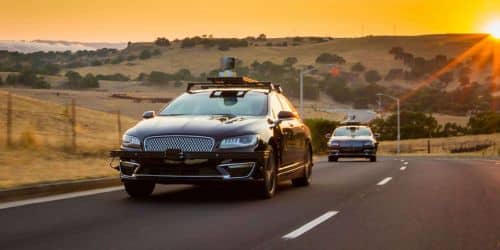Although driverless cars appear to be a thing of the future, this future may already be here due to advancements in the field of autonomous driving. Similar to the gradual adoption of electric cars, automakers have been incorporating driverless features into conventional vehicles for some time, with hybrid models being the first to enter service. Our current fleet of automobiles consists of self-parking, cruise control, braking assistance, and semi-autonomous automobiles. Additionally, industry experts anticipate that within a few years, fully autonomous vehicles may be available for purchase. In Phoenix, Uber and Waymo are collaborating to provide rides in fully autonomous vehicles, beginning a relationship that could be very advantageous for both businesses.
Driverless Cars
A self-driving car runs without a human driver having to steer or press a pedal. Even though the technology is available, there are not any fully autonomous self-driving vehicles on the road at the moment. With its vehicles that, in some circumstances, can drive themselves, Tesla has come the closest. However, drivers must still pay attention to the road.
Autonomous emergency braking systems, adaptive cruise control, high-definition maps that make use of sensor data collected in near-real time, blind spot detection, and other features are some of the most popular and user-friendly characteristics of the best driverless cars.
Driverless cars, also known as autonomous cars or self-driving cars, are vehicles that can drive themselves using sensors, cameras, radar, and artificial intelligence (AI).
To categorize driverless cars, the Society of Automotive Engineers (SAE) established five levels of autonomy. Although level five prototypes are currently undergoing testing and level four autonomous vehicles are to be on the road within the next ten years, the majority of cars currently on the road are level two vehicles.
Levels of Vehicular Autonomy
#1. Level One: Driver Assistance
The car can help the driver with basic tasks like steering, braking, and acceleration. This category includes the majority of vehicles currently on the road.
#2. Level Two: Partial Automation
It is possible for two or more automated processes, like automatic braking and cruise control, to operate side by side. The driver must be fully committed when operating a level two vehicle.
#3. Level Three: Conditional Automation
In some circumstances, primarily on highways, the vehicle is capable of operating on its own, but the driver must always be alert and ready to take control at any time.
#4. Level Four: High Automation
At this level, the car can drive itself and does not need a human driver. In this situation, an ADS is capable of managing all aspects of driving, including environmental monitoring. The human driver does not need to pay attention because the ADS is trustworthy enough in those situations.
#5. Level Five: Full Automation
In every situation and setting, the vehicle is fully autonomous. The ADS of the vehicle drives exclusively in all situations, serving as a virtual chauffeur. There is never any expectation for the human occupants to operate the vehicle as drivers.
How to Do Driverless Cars Work
Artificial intelligence technologies power self-driving car systems. Machine learning and neural networks combined with massive amounts of data from image recognition systems to create driverless cars.
To feed the machine learning algorithms, the neural networks analyze the data to find patterns. Images captured by self-driving car cameras are among the data sources used by the neural network to train itself to recognize objects such as traffic lights, trees, curbs, pedestrians, street signs, and other elements of a given driving environment.
Driverless cars’ primary objective is to safely navigate from point A to point B. They use an established map to accomplish this. This map is what we refer to as an HD Map. Radar, cameras, LiDAR, and GPS are used in conjunction by driverless cars to locate themselves and other nearby vehicles on their HD Map.
Benefits of Driverless Cars
#1. Lower Accident Rate
The ability to connect is a key component of autonomous vehicles. Autonomous vehicles that are connected to the Internet of Things can share information about roadblocks or nearby accidents. A road with many autonomous vehicles means a road without drowsy, fatigued, or drunk drivers, even in the absence of connectivity.
Senior citizens and people with disabilities would have more accessibility options in a world where driverless cars are the norm. For a variety of reasons, people who can not or should not drive would be able to get their groceries or go to their doctor appointments without worrying.
#3. Safe Streets
It is expected that driverless cars will reduce gridlock and improve traffic flow, making the streets safer for all users. The development of autonomous vehicles must first overcome obstacles like inconsistent road markings between cities and states, collisions that obstruct camera and sensor views, construction activities, and bad weather. Before autonomous vehicles take over our roads, there must be infrastructure upgrades that include radio transmitters, more powerful mobile and wireless networks, and communication standards.
#4. Greater Opportunities for More People
People with disabilities might have access to autonomous vehicles that would offer them dependable and safe transportation. A recent white paper claims it can create up to 2 million jobs and those driverless cars could prevent up to $19 billion in medical costs annually from missed appointments. driverless cars may help the disabled feel less alone and have a better quality of life.
#5. Decrease in Carbon Footprint
The self-driving car industry is moving more and more toward electric vehicles and other clean energy sources like hydrogen. Thus, having these vehicles on the road can undoubtedly contribute to significantly lowering the carbon footprint of humans.
Additionally, using a communication network, driverless cars will be able to travel in sync. Consequently, it will lessen the energy loss caused by frequent braking in traffic.
Challenges of Driverless Cars
#1. Motion Sickness
When the movement you perceive does not match the movement that your inner ear anticipates, motion sickness results. Some people experience this when trying to read a book while driving. In autonomous vehicles, motion sickness is more likely due to two factors. First, motion sickness might set in if you can not predict where and when the car will move. Additionally, if you do not keep your eyes on the motion-prone area, you could easily get motion sickness.
#2. Issues With Security
The risk of hacking is one potential drawback of driverless cars. Automated vehicles would require a common network protocol to communicate and work together. However, they would be vulnerable to a hack if numerous cars shared the same network. On congested roads, even a minor hack could cause significant harm by causing collisions and snarling traffic.
#3. Job Losses
With the advent of driverless cars, those whose livelihood depends on driving may find their profession obsolete. Drivers in the transportation sector, including those in the taxi and bus industries, will all need to look for new jobs. Additionally, automated cars would displace Uber and fast food delivery drivers.
#4. Accident Liability
Accident liability in the context of autonomous vehicles refers to who is responsible for an accident brought on by one. More recent autonomous vehicle designs will not have a dashboard, steering wheel, or brake pedals as we get closer to the point of maximum autonomy. When a car is driven without human input, it is much harder for police forces and insurance companies to determine who is at fault. Legislators at the state and federal levels will need to get involved for us to determine who is responsible for the autonomous vehicle’s occupants and who is the car manufacturer.
Driverless Cars Uber
Since the establishment of Waymo, Google’s self-driving car division, in 2009, Alphabet has become a leader in the robotaxi industry, with Phoenix, Arizona, boasting the 180 square miles largest service area in the world.
In 2015, Uber, the largest ridesharing company in the world, began to worry that autonomous vehicles posed a threat to its business model. As a result, it established a division devoted to internally developing these vehicles. When Uber allegedly stole trade secrets from Waymo two years later, Waymo filed a lawsuit. Uber stopped operating its self-driving vehicles after paying a multi-million dollar settlement (and a pedestrian died in the process), and by 2020, it had sold the division.
Currently, Uber and Waymo are working together. On May 23, Uber revealed that a “set number” of its former rival’s autonomous vehicles will be available for hailing through the Uber app later this year. While the alliance will enable Uber to meet changing customer expectations, Waymo will gain immediate access to Uber’s sizable customer base. That should enable it to achieve its objective of providing ten times as many rides by the summer of 2024.
How Much Will Driverless Cars Reduce Accidents?
According to McKinsey, the number of fatal accidents may drop by as much as 90% as a result of self-driving vehicles. Car accidents would become the ninth-leading cause of accident-related fatalities in the United States if this happened, down from the second-leading cause currently being traffic accidents.
How Do Driverless Cars Work?
The software that autonomous cars use to operate is executed by sensors, actuators, sophisticated algorithms, machine learning systems, and robust processors. A map of their surroundings is built and updated by autonomous vehicles using a variety of sensors placed throughout the vehicle.
Driverless cars are now capable of navigating roads without the assistance of a human driver thanks to automated safety features. Radar, GPS, cameras, software, and other sensors work together to control how an autonomous vehicle drives and navigates on roads.
Are There Any Driverless Cars Yet?
Although there are currently no fully autonomous vehicles available for purchase, some automakers are developing the technology. A few vehicles have recently entered the market with driver assistance features that significantly reduce the driver’s workload.
What Year Will We Have Driverless Cars?
A recent forecast from research company GlobalData states that the autonomous vehicle (AV) industry will not create a fully self-driving car until 2035. The research company predicted in a report that over the following few years, fully autonomous vehicle deployment timelines (Level 5) would be delayed. According to experts, it will not likely happen until 2035 before we start seeing fully automated cars on the roads. But starting in 2024, partially automated cars will be on the market.
Are Driverless Cars Good or Bad?
The potential for greater independence for people with disabilities is a major advantage of driverless cars. People with physical limitations or poor vision
Conclusion
Social and political change has always been facilitated by advances in technology. The public and government will be more willing to trust autonomous vehicles as long as the automotive behemoths continue to advance the technology. To achieve fully autonomous driving, however, this process will be gradual as cars acquire varying degrees of autonomy.
Related Articles
- UBER INSURANCE: Where To Buy It and How It Works
- JOB CHARACTERISTICS MODEL: Detailed Guide
- UBER REQUIREMENTS: Uber Drivers Requirements
- SHARED LEADERSHIP: Overview, Model, Examples, Theory






